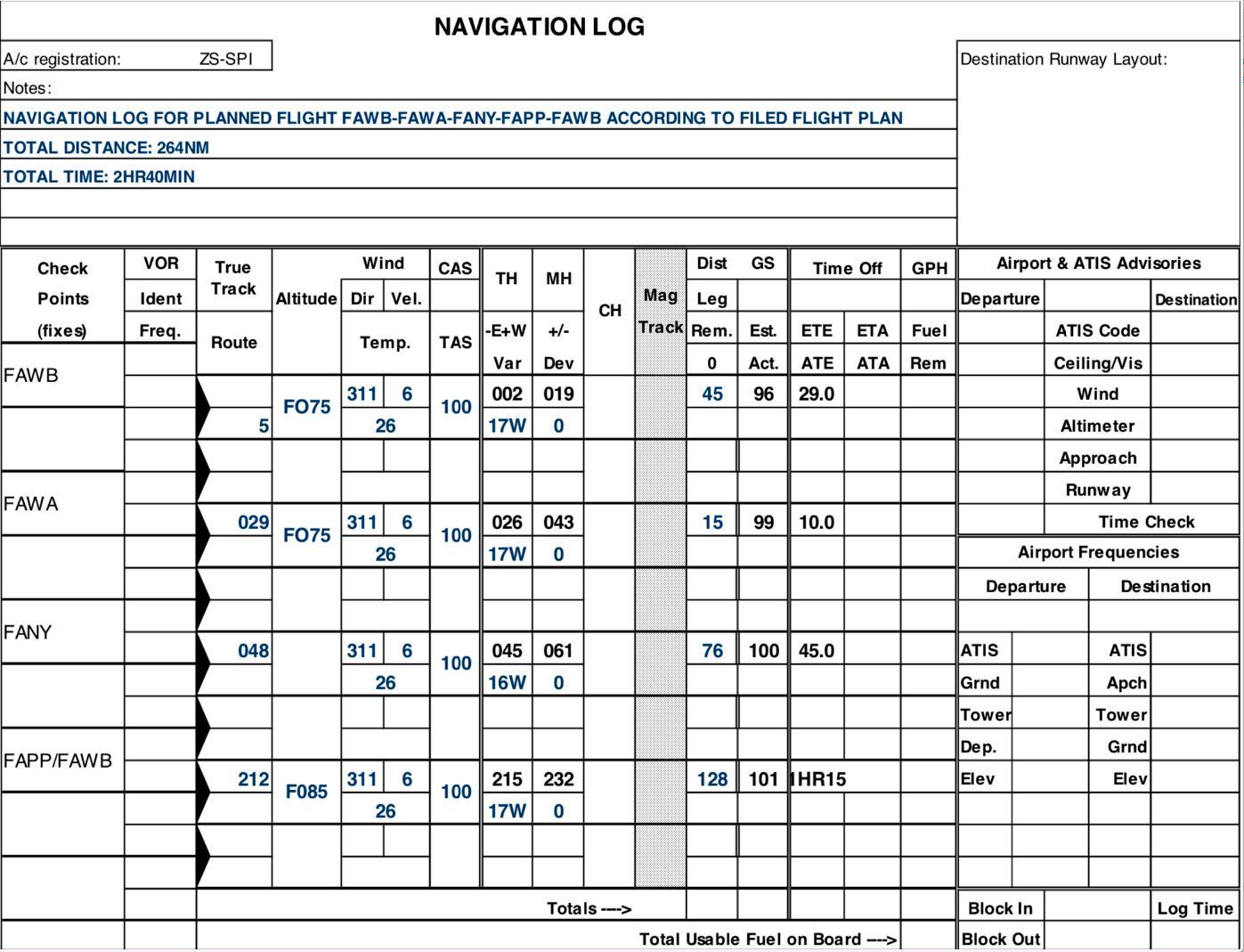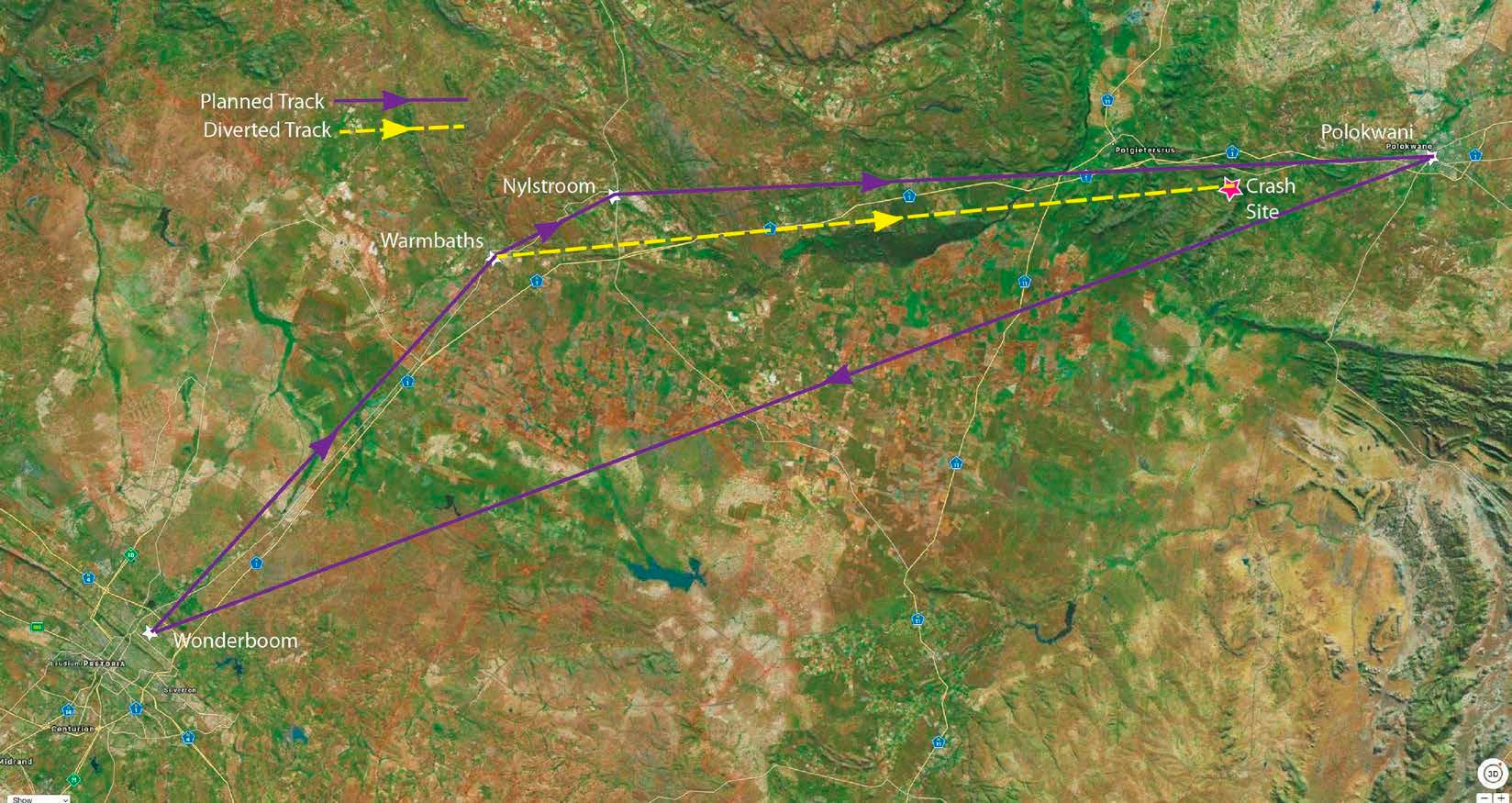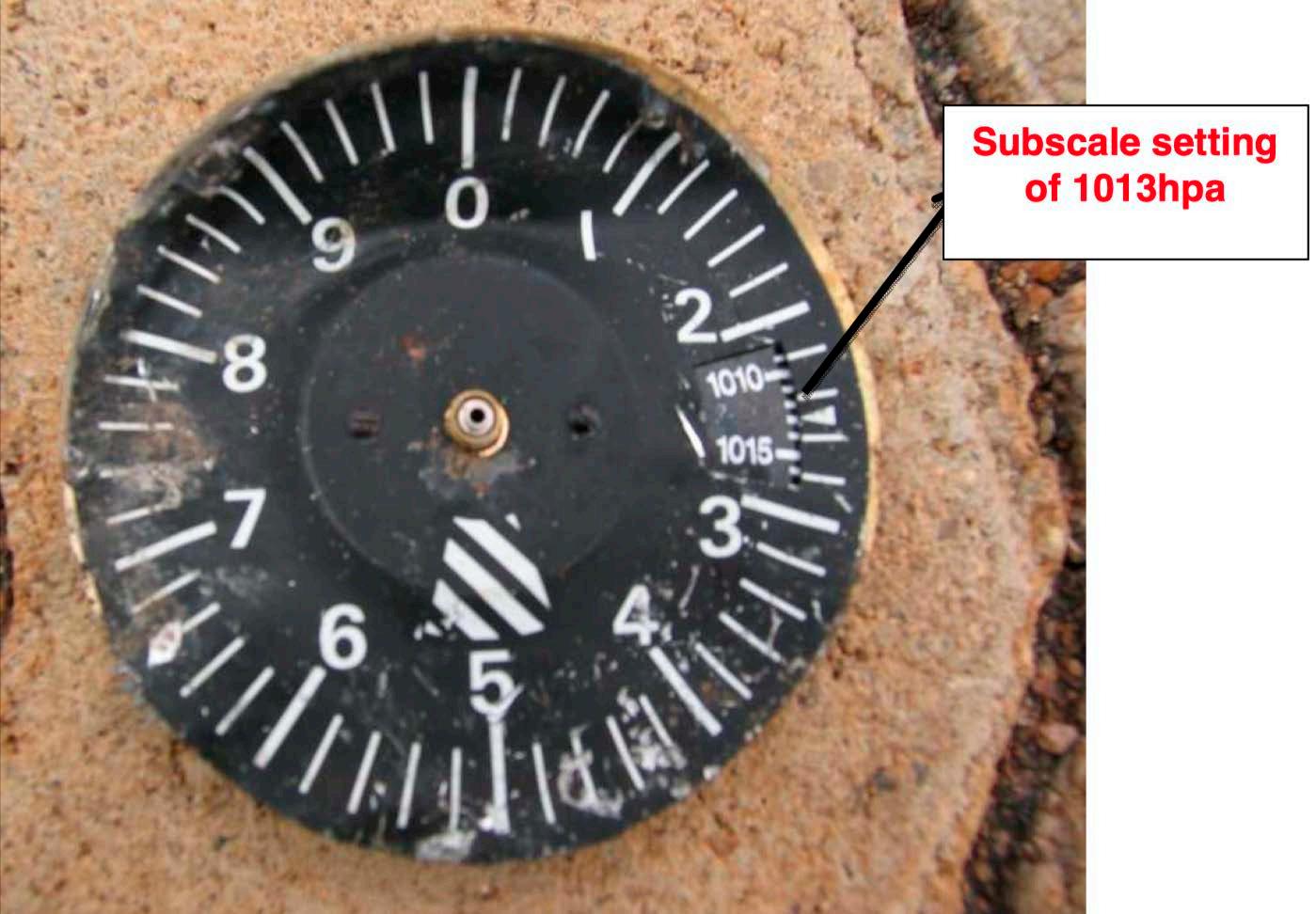
15 minute read
Jim Davis - ACCIDENT REPORT
AIRCRAFT ACCIDENT REPORT
NOTE: THIS REPORT IS TO PROMOTE AVIATION SAFETY AND NOT TO ESTABLISH LEGAL LIABILITY.
Advertisement
Unless stated otherwise all times are local (Bravo time)
The CAA’s 30 page report contains a large amount of padding, repetition, poor English and incompetence. Here’s an example of the latter: The estimated flight time was three hours, ten minutes {(0310) (at flight level 075 feet above mean sea level) (AMSL)}. So, in the interest of clarity and readability, I have had to correct and paraphrase extensively.
ACCIDENT REPORT:
Aircraft Registration: ZS-SPI Date of Accident: 09 Nov 2012 Time of Accident: 8.59 pm Type of Aircraft: Cessna 172R Pilot-in-command: a 24 year old Nigerian national with a valid PPL and night rating. Total flying: 194 hours On type: 158 hours
Last Point of departure:
Wonderboom (FAWB)
Final place of intended landing:
Wonderboom (FAWB)
Accident site:
On a mountain at GPS coordinates (S 24° 07 6.76 E 029° 13 7.58) at 5 940 feet AMSL. Persons on board: 1+1 Persons killed: 1+1
METEOROLOGICAL INFORMATION:
Satellite image. The satellite image indicated overcast low-level cloud in the area. And the 21:00Z SIGWX chart forecast scattered lowlevel cloud base of 1,000ft, poor visibility and moderate low-level turbulence in the area of the accident. Observed weather Polokwane Airport 18:00Z METAR indicated overcast low-level cloud at 2000ft, good visibility and light north easterly winds. 1900Z & 2000Z AUTO METARs indicated that the dew-point depression decreased by a degree from 18:00Z to 2°C i.e. possible indication of 500ft to 1000ft cloud base drop close to the time of the accident.
SYNOPSIS
At 7.58 pm the pilot and a passenger departed Wonderboom on a private VFR flight to build night hours. According to ATC, takeoff and climb out from Wonderboom appeared to be normal. There was no further communication between the pilot and ATC. The aircraft did not return to Wonderboom as planned. The flight plan was direct to Warmbaths, then direct to Nylstroom, then direct to Polokwane where he would do a touch and go, and then return to Wonderboom. The following day the aircraft was found to
have hit a mountain 21 nautical miles south of Polokwane. The aircraft was destroyed on impact and the occupants were pronounced dead on the scene.
ADDITIONAL INFORMATION:
When the aircraft departed Wonderboom the school was hosting a year-end function. The flight school indicated that a designated flight instructor had checked the pilot’s flight planning prior to departure and found it satisfactory. The local QNH at FAPP was 1018 hpa. However the altimeter at the accident site was set on 1013 hpa. According to radar, the accident occurred an hour after departure at 8.59 pm. Search and Rescue was started when the pilot failed to cancel his SAR. The police and emergency medical services (EMS) were notified. The following morning at 10.15 the search mission was started by a police helicopter. However it was called off due to poor weather. At 11.25 the search recommenced and the aircraft was found on the side of a mountain. A farm worker told the investigators he had seen a small single engine aircraft with flashing navigation lights routing in a south westerly direction. Then he heard a loud explosion. ATC at Polokwane said the pilot phoned approximately 1.5 hours before departure enquiring if the runway lights would be on. The controller confirmed the lights are on permanently. He also advised the pilot that the weather was not good. He recommended that the pilot reconsider his flight into FAPP. The pilot phoned again just before the ATC’s shift ended at 8 pm. He asked for an update of the weather at FAPP, which was still VMC but overcast at 2000 feet with visibility of 8000 metres. The next morning when the tower reopened, they received a call from FAWB tower asking if ZS-SPI was parked there. The answer was negative. Radar images show deviations from the intended flight plan. The pilot routed directly to Polokwane from Warmbaths, instead of going via Nylstroom. It is not known if the diversion was planned prior to departure. The aircraft completed a left hand orbit immediately prior to the accident. It then headed directly into the mountain. Prior to impact it was descending and its groundspeed varied between 120 and 150kts.
The tragic remains of a student night hour building flight gone wrong

During on site investigation, the team could smell fuel, but it was not possible to determine the position of the fuel selector. All the seats were still secured to their anchors inside the wreckage and both occupants seat belts snapped.
ANALYSIS:
The pilot was a commercial student at an ATO and was completing training towards his Instrument rating for his Commercial Pilot’s License. He had completed seventeen hours of dual instrument simulator training prior to the accident. His progress reports stated that he was inconsistent. His instructor said that he was eager to complete his training and return to his home country, however he was not utilising his time to prepare sufficiently for his simulator lessons. The flight level planned for the flight was 075. This would have given minimal terrain clearance. The minimum safe altitude for an IFR flight was 9000ft. So flight level 095 would have been required, but this would have placed the aircraft in cloud. As it was a VFR flight the pilot opted for flight-level 075. The pilot’s navigation log and map were recovered at the accident site. The navigation log did not contain any en-route checkpoints and there were no tracks drawn on the map.
JIM’S COMMENTS:
There is so much wrong here that it is hard to know where to start. Unfortunately this accident is representative of the low standard of training at some of the flight schools that are cashing in on the foreign student market. Let’s try to figure out what was going on. The fact that the student was in a hurry to finish his training and return home, patently influenced his decision to fly that night.
There is always GO pressure once you have There was no flight planning. The flight log driven out to the airfield. You don’t want to waste was not used and no tracks were drawn on the drive or disappoint your pax. And the same his 1:1,000,000 chart found in the wreckage. I pressure is present to continue the flight into have just drawn his track on a WAC chart and deteriorating weather conditions. the mountain that he hit is clearly marked with The weather would have been marginal for a day flight. To me it was little short of criminal stupidity to fly into low cloud on a completely black night. I have checked and there was no is a spot-height of 6770’. This means he had started descending from flight level 075, without knowing, or setting the QNH, before he had his destination in sight. moon that night. It’s quite spooky to be doing his flight planning During the day you can make weather related decisions enroute. At night his is often not possible – you are likely to fly into cloud before for him, with lines on paper maps, nearly ten years after he and his instructor should have done it. you see it. Also, updated The student obviously weather reports from ATC are often not available as ATC advised intended using his phone/ GPS instead of navigating many airfields close for the night. the pilot that properly. I discussed this problem with my friend A night rating earned while flying around a city simply does not prepare a pilot for flying elsewhere. While instructing at Rundu one of my pupils decided that my requirements for getting a night rating were excessive so he did his night training in Johannesburg with a ‘friend’. One evening about a week later I was called Wally Waldeck who owns FTC in George. He said he had to allow pupils to take their phones on all crosscountries, day or night, in case they had to divert or do precautionary landing, or any other problem. He now plans to put their phones in a sealed envelopes before departure. the weather was not good out from dinner to identify the charred bodies of This pilot’s diversion was unplanned and he did himself, his wife and a friend. He had lost control not inform ATC. This was very foolish because of the aircraft almost immediately after takeoff on SAR teams will look for you where you are a black night. supposed to be – not where you have decided to go.

If the report is correct, the pilot would not qualify for a night rating because all his 17 hours of instrument flying had been in a simulator. The Regs call for at least five hours IF in an aircraft. I believe the pilot’s simulator time very likely gave him a false confidence that he could handle flying into cloud at night.
The instructor who is reported to have signed him out was possibly distracted by the company’s end-of-year function. I can’t believe that he personally checked on the weather and the flight planning, and then signed his approval for the flight to proceed. There is no written evidence that this actually happened. To me that the flight was also illegal because night VFR requires that the flight be flown with visual reference to identifiable objects on the surface. It was established in court, following another fatal night VFR flight, that lights on the ground do not constitute identifiable objects. At my own flying school I made a rule that there must be half a moon, or more, visible for the duration of the flight. Many other schools use the same rule. But it is not the law. Had the pilot planned the flight properly he could have routed along the N1 highway, which would have given him a reliable navigation feature with its four well-lit toll-gates. I believe that the school, and the instructor, have a moral responsibility to wait for the student’s return from any cross-country - but particularly a night one. I am appalled that this apparently did not happen. This leads us into muddy waters. Legally there is no requirement for this if a correctly licensed and rated pilot hires an aircraft. However, does the fact that the student is on a full-time, specific

Basic errors - despite being below the transition altitude the 1013 QNE was still set on the altimeter
course mean that the school has a moral duty of care? I would say so. But, does this mean that they do not have the same responsibility for a walk-in hirer. This is one for the law courts to sort out. The 360 on the radar track, moments before he flew into the mountain was either the start of a classic graveyard spiral, or maybe the pilot spotted lights through a gap in the cloud and
So near the top - but unseeable on a dark night
was trying to orientate himself. The report correctly notes that strobes and rotating beacons should be turned off at night or in haze as they tend to increase the chance of suffering from vertigo and disorientation. The report says that post-mortem and blood toxicology reports were still outstanding at the time of compiling this report. I believe this to be nonsense because every single accident report I
have seen says exactly the same thing. It seems likely that the accident investigators simply can’t be bothered. This is disgraceful, it means that we will never know whether alcohol or drugs were involved - in this or any other accident. The student’s file notes that his progress was ‘inconsistent’. This is one of the known warning signs that drugs may be involved. This may seem harsh, but I have asked around the flying schools who take it upon themselves to conduct random drug tests, and it seems that on average, between 10% and 20% of students tested were indeed on marijuana. The CAA’s failure to take toxicology reporting seriously is to be deplored. If the government labs can’t handle them, then they should be contracted out to private enterprise in the same way that private AMOs are detailed to investigate possible mechanical failures.

simulator time gave him a false confidence
The aircraft hit a mountain that was almost on track, 2000’ above airfield elevation, and only 21 miles from the airfield. This tells me that the pilot did not know where he was due to poor navigation and/or poor flight planning.
The school must have been aware of this hazard and seemingly failed to brief the student properly. The report recommended that ATOs should be made to implement monitoring programmes for students doing commercial pilot training. This should prevent pilots with little experience from making poor decisions that may be influenced by circumstances such as time and financial constraints. This excellent recommendation has not been acted upon in ten years. And while I am hammering the CAA - the 30 page report is undated and unsigned. I have no idea when it came out.
TAKE HOME POINTS:
• Never fly when you are in a hurry or under pressure. • You often can’t see bad weather at night so it’s critical to make weather decisions on the ground. • Night flying should be with a visible horizon and at least half a moon. • You must be able to navigate using
‘identifiable’ objects on the ground. • A night rating earned in city lighting is likely to kill you. • Flight logs and lines on maps are primary navigation tools. GPS may be used as a backup. • If you divert – tell someone, otherwise SAR is meaningless. • The bit of instrument flying that you need for a night rating does not qualify you to fly in cloud or on a black night. • Instructors – be very aware of your responsibilities when signing pupils out – particularly at night. I know an instructor who killed three pupils before CAA finally shut him down. • Instructors – be on the lookout for signs of drug or alcohol abuse in pupils. • Flight planning is important during the day and critical at night. • If strobes and beacons are distracting – switch them off. j

JONKER SAILPLANES JS2 FLIES
The much anticipated JS-2 self launched glider has now flown. Image Bennie Henning

THE FIRST FLIGHT of the long desired JS2 self-launching glider from Jonker Brothers in Potchefstroom happened on 26 March 2020.
Powered by a fold away 64hp two stroke piston engine the flight was launched with a tow to establish the flight characteristics of the JS-2. The retractable pylon thrust system, using the SOLO 2625 02i two-stroke 625cc inline twin-cylinder liquid-cooled aircraft engine with electronic fuel injection and dual sparkplug high-voltage ignition system, mated to and in house optimally designed propeller makes light work out of take-off climb at MTOW.
The new generation electronically fuel injected system ensures for a much more economic fuel consumption, allowing approx. 1, 5 hrs. of engine operation. The JS2 wings have been constructed with the JS5-concept water system in addition to the integrated fuel tanks. Jonker Sailplanes says that the development of the JS2 Self Launcher was not about the development of a self-launching glider based on the highly successful JS1. The original idea – to build a new fuselage with enough space to fit a SOLO 2650 engine grew in scope until the glider is now unrecognisable from the original JS1. This is because as the JS1 self-launcher developed, Jonker Sailplanes developed as a company. For a time, the development of the JS2 was stopped in order to design, certify, industrialise and produce the JS3. However the development and production of the JS3 meant that even more lessons were learn before returning to the JS2 (this during a span of 4 years). With the first flight having been successfully carried out, the JS2 design data and tooling should be handed over to production from April 2021 and the team aims to complete certification within 12 months after the test flights have started. Before the flight-testing stage, various ground-tests were completed resulting in small design changes which need time to be evaluated and incorporated jin the design data pack.
I PRESSED ON ANYWAY Rural Poland is filled with cathdrals with beautiful waitresses
and soon came down in a wheat field that had been cut down to short stubble in a little village with a huge cathedral. The crowds of children were understandably excited and I couldn’t communicate with them until a young trainee monk rode up on his bicycle speaking impeccable English. My crew had damaged the trailer’s axle and was going to be late, so I accepted Michael’s invitation to tour the magnificent cathedral that dominated the landscape. The cathedral was a spectacular reminder of Poland in her former glory and boasted oil paintings 30 feet in height. I was taken to a reception room where I was told that coffee and cake would be served. After a short wait the massive door opened and a silver platter and coffee pot was deferentially placed before me by quite the most I asked Michael whether there was anything I beautiful young woman I have ever seen. I felt could buy for him at the shops and he cocked quite out of place amongst all this beauty and his eye at the bottle store. The bottle of Vodka I splendour dressed as scruffily as I was in my bought was quickly slipped up his cassock into khaki shorts and retired long-sleeve shirt. some secret pocket as he gave the girls a wide After coffee the tour continued with a visit to the grin. I assumed he was not going to take his living quarters and there at last I understood vows too soon. why the trainee monks all walked around with Lesson: Although I would have liked to be more a perpetual smile on their faces – they had at presentable in such a humbling environment, I their beck and call a harem of gorgeous young always make sure that in my glider I have warm girls who did the cooking, laundry and cleaning clothes and shoes suitable for a long walk. It for the monastery. My crew, Daniel Perry, duly can turn surprisingly cold in hot climates after a arrived, and he too was mesmerised by the girls thunderstorm shoots you down. I also religiously who came down to help with the glider. apply sun-cream to my neck in case of a long walk after an outlanding. j






